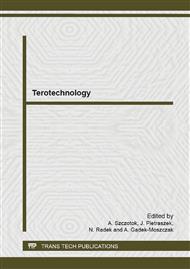[1]
R. L. Webb, Kim Nae-Hyun, Principles of Enhanced Heat Transfer, second ed., Taylor & Francis, New York, (2005).
Google Scholar
[2]
B. J. Jones, J.P. McHale, S. Garimella, The Influence of Surface Roughness on Nucleate Pool Boiling Heat Transfer, ASME J. of Heat Transfer. 131 (2009) 121009-1 – 121009-14.
DOI: 10.1115/1.3220144
Google Scholar
[3]
R. I. Vachon, G.E. Tanger, D.L. Davis, G.H. Nix, Pool boiling on polished and chemically etched stainless steel surfaces, ASME J. of Heat Transfer. 90 (1968) 231-238.
DOI: 10.1115/1.3597486
Google Scholar
[4]
T.M. Wójcik, Experimental Investigations of Boiling Heat Transfer Hysteresis on Sintered, Metal – Fibrous, Porous Structures, Exp. Therm. Fluid Sci. 33 (2009) 397-404.
DOI: 10.1016/j.expthermflusci.2008.10.011
Google Scholar
[5]
J. P. McHale, S.V. Garimella, Nucleate Boiling from smooth and rough surfaces – Part 1: Fabrication and characterization of an optically transparent heater-sensor substrate with controlled surface roughness, Exp. Therm. Fluid Sci. 44 (2013).
DOI: 10.1016/j.expthermflusci.2012.08.006
Google Scholar
[6]
M. Faucheux, G. Muller, M. Havet, A. Lebail, Influence of surface roughness on the supercooling degree: Case of selected water/ethanol solutions frozen on aluminium surfaces, Int. J. Refrigeration. 29 (2006) 1218-1224.
DOI: 10.1016/j.ijrefrig.2006.01.002
Google Scholar
[7]
J. M. Saiz Jabardo, G. Ribatski, E. Stelute, Roughness and surface material effects on nucleate boiling heat transfer from cylindrical surfaces to refrigerants R-134a and R-123, Exp. Therm. Fluid Sci. 33 (2009) 579-590.
DOI: 10.1016/j.expthermflusci.2008.12.004
Google Scholar
[8]
U.P. Hwang, K.P. Moran, Boiling heat transfer of Silicon integrated circuits chip mounted on a substrate, ASME J. of Heat Transfer. 20 (1981) 231-238.
Google Scholar
[9]
T. Orzechowski, Boiling heat transfer on fins with structural microcoverings, Kielce University of Technology, Kielce, Poland, 2003 (In polish).
Google Scholar
[10]
N. Radek, Ł.J. Orman, Preliminary data of boiling heat transfer of laser treated heatexchanger surfaces, in: J.I. Shalapko, L.A. Dobrzański (Eds. ), Scientific basis of modern technologies: experience and prospects, Khmelnytskyi National University, Jaremche, Ukraine, 2011, pp.236-245.
Google Scholar
[11]
B. Grabas, Polish Patent 207358 (2010).
Google Scholar
[12]
B. Grabas, Polish Patent 210889 (2011).
Google Scholar


